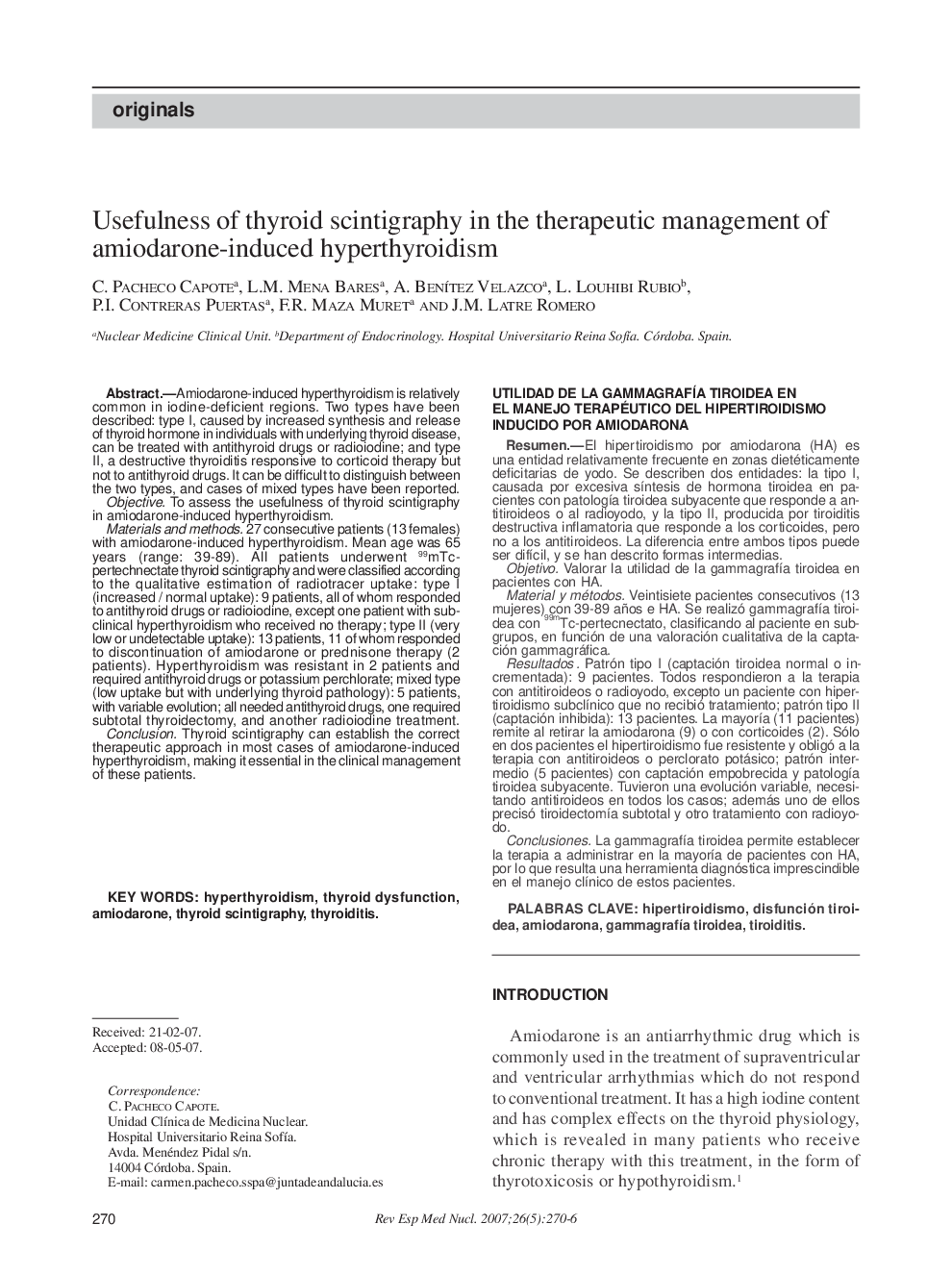| Article ID | Journal | Published Year | Pages | File Type |
|---|---|---|---|---|
| 4249634 | Revista Española de Medicina Nuclear (English Edition) | 2007 | 7 Pages |
Amiodarone-induced hyperthyroidism is relatively common in iodine-deficient regions. Two types have been described: type I, caused by increased synthesis and release of thyroid hormone in individuals with underlying thyroid disease, can be treated with antithyroid drugs or radioiodine; and type II, a destructive thyroiditis responsive to corticoid therapy but not to antithyroid drugs. It can be difficult to distinguish between the two types, and cases of mixed types have been reported.ObjectiveTo assess the usefulness of thyroid scintigraphy in amiodarone-induced hyperthyroidism.Materials and methods27 consecutive patients (13 females) with amiodarone-induced hyperthyroidism. Mean age was 65 years (range: 39-89). All patients underwent 99mT-cpertechnectate thyroid scintigraphy and were classified according to the qualitative estimation of radiotracer uptake: type I (increased / normal uptake): 9 patients, all of whom responded to antithyroid drugs or radioiodine, except one patient with subclinical hyperthyroidism who received no therapy; type II (very low or undetectable uptake): 13 patients, 11 of whom responded to discontinuation of amiodarone or prednisone therapy (2 patients). Hyperthyroidism was resistant in 2 patients and required antithyroid drugs or potassium perchlorate; mixed type (low uptake but with underlying thyroid pathology): 5 patients, with variable evolution; all needed antithyroid drugs, one required subtotal thyroidectomy, and another radioiodine treatment.ConclusionThyroid scintigraphy can establish the correct therapeutic approach in most cases of amiodarone-induced hyperthyroidism, making it essential in the clinical management of these patients.
ResumenEl hipertiroidismo por amiodarona (HA) es una entidad relativamente frecuente en zonas dietéticamente deficitarias de yodo. Se describen dos entidades: la tipo I, causada por excesiva síntesis de hormona tiroidea en pacientes con patología tiroidea subyacente que responde a antitiroideos o al radioyodo, y la tipo II, producida por tiroiditis destructiva inflamatoria que responde a los corticoides, pero no a los antitiroideos. La diferencia entre ambos tipos puede ser difícil, y se han descrito formas intermedias.ObjetivoValorar la utilidad de la gammagrafía tiroidea en pacientes con HA.Material y métodosVeintisiete pacientes consecutivos (13 mujeres) con 39-89 años e HA. Se realizó gammagrafía tiroidea con 99mTc-pertecnectato, clasificando al paciente en subgrupos, en función de una valoración cualitativa de la captación gammagráfica.ResultadosPatrón tipo I (captación tiroidea normal o incrementada): 9 pacientes. Todos respondieron a la terapia con antitiroideos o radioyodo, excepto un paciente con hipertiroidismo subclínico que no recibió tratamiento; patrón tipo II (captación inhibida): 13 pacientes. La mayoría (11 pacientes) remite al retirar la amiodarona (9) o con corticoides (2). Sólo en dos pacientes el hipertiroidismo fue resistente y obligó a la terapia con antitiroideos o perclorato potásico; patrón intermedio (5 pacientes) con captación empobrecida y patología tiroidea subyacente. Tuvieron una evolución variable, necesitando antitiroideos en todos los casos; además uno de ellos precisó tiroidectomía subtotal y otro tratamiento con radioyodo.ConclusionesLa gammagrafía tiroidea permite establecer la terapia a administrar en la mayoría de pacientes con HA, por lo que resulta una herramienta diagnóstica imprescindible en el manejo clínico de estos pacientes.
